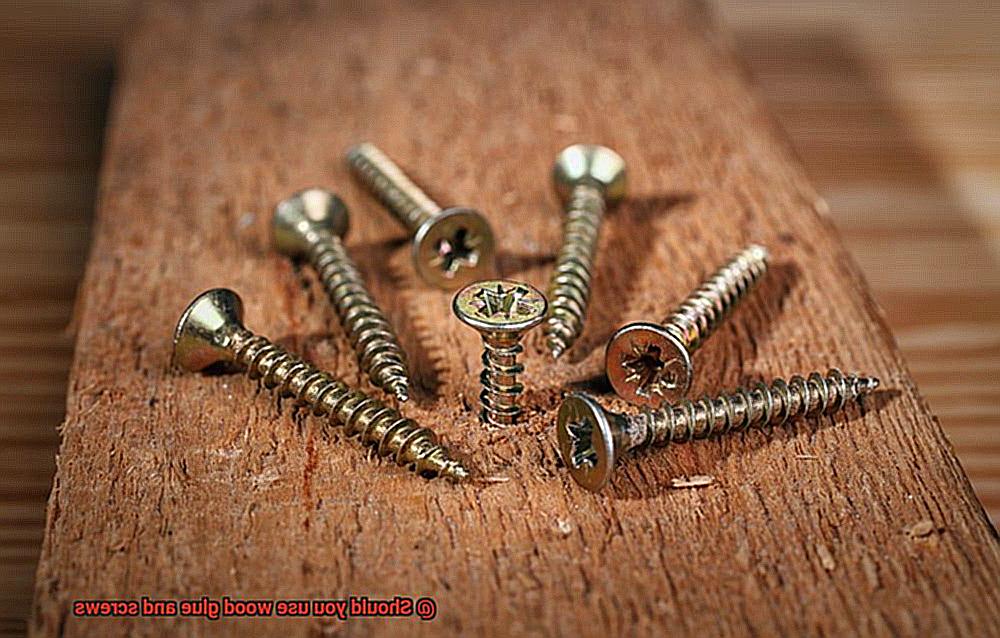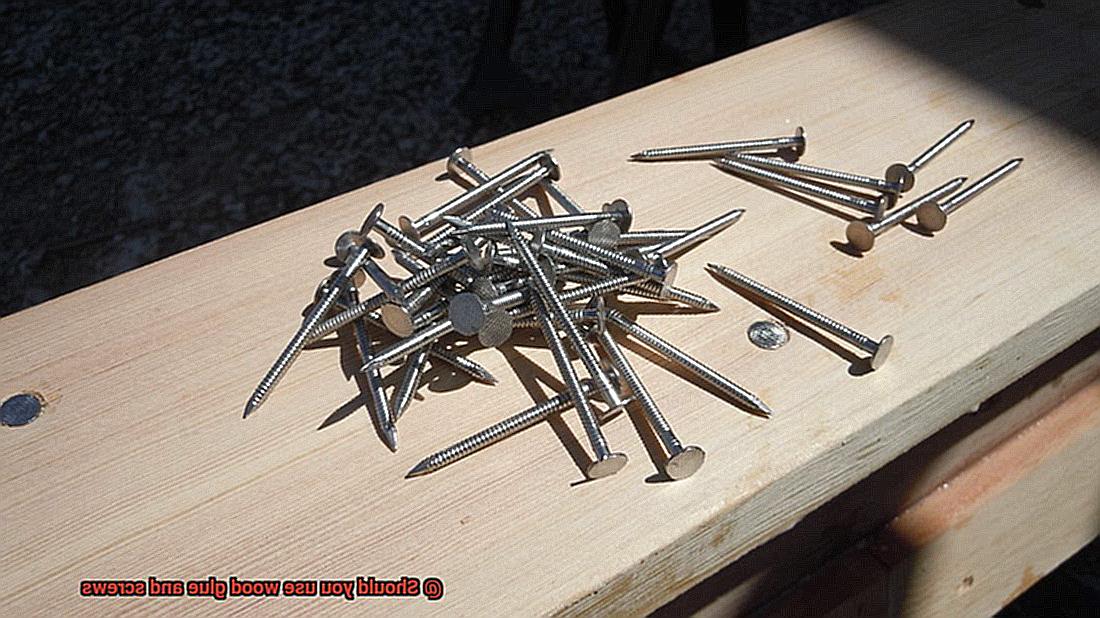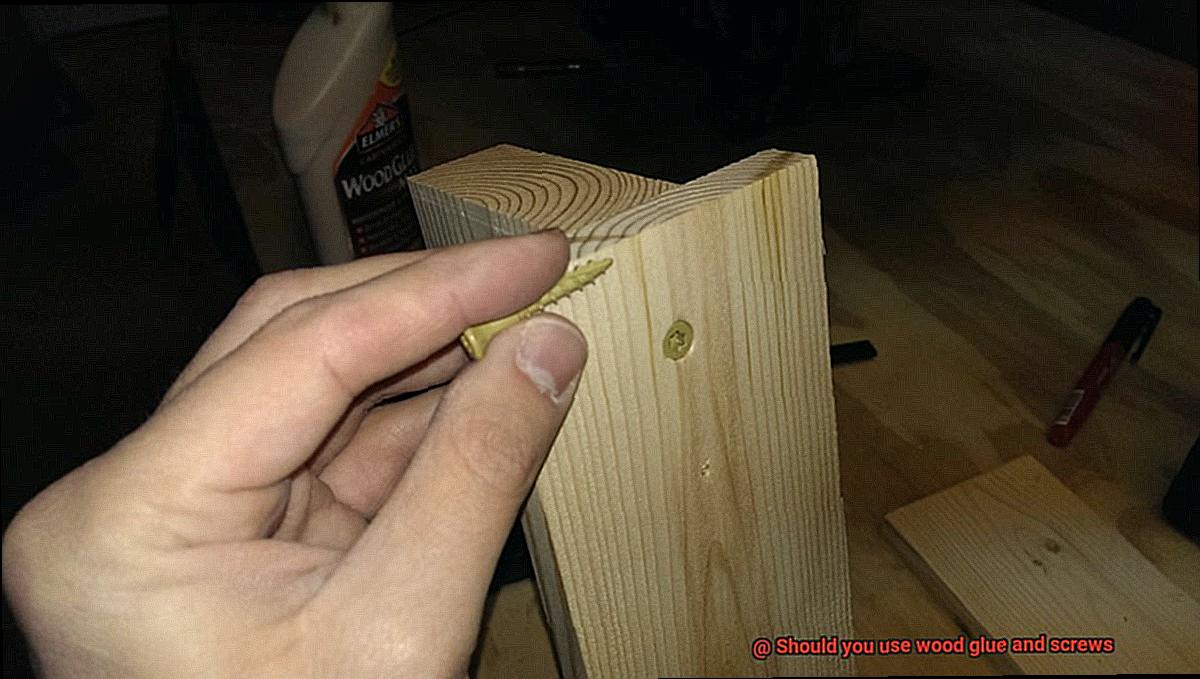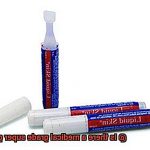Picture this: you, standing in the hardware aisle, eyes darting between rows of adhesive options, feeling like a lost puppy in a maze. We’ve all been there, my friend. Choosing between wood glue and screws can be as mystifying as deciphering ancient hieroglyphics. But fear not. Today, we’re diving headfirst into the enchanting world of wood glue and screws to uncover the truth behind their magical bond.
As a homeowner, you know that when it comes to fixing things around the house, having options is key. And boy, do we have options. But let’s focus on the tantalizing tango between wood glue and screws. Should you stick with tradition or venture into uncharted territory? Buckle up because we’re about to embark on an adventure that will leave you spellbound.
Wood glue beckons us with its siren song of strength and durability. This sticky sorcery works wonders in creating robust joints that can withstand the test of time. Application is a breeze – no need for fancy tools or complicated rituals. Just slather some gooey goodness onto those mating surfaces, press them together like long-lost lovers reuniting, and ta-da.
However, hold your horses; there’s a catch. Wood glue requires patience – clamping and drying time that might cramp your style if you’re working against the clock or itching to show off your masterpiece.
Enter screws – the knights in shining armor of woodworking. These metal warriors offer a level of security that would make even Fort Knox jealous. They reinforce stability like nobody’s business and can be easily unscrewed if needed (unlike that pickle jar lid that never seems to budge). With an army of screw types and sizes at your disposal, you’ll feel like a general commanding an unstoppable force. But, fair warning, screwing ain’t for the faint of heart. It demands precision drilling, screwing techniques that would make a surgeon jealous, and a whole arsenal of tools.
So, my friend, which path will you choose? Stick with the tried-and-true wood glue or take a leap into the realm of screws? Join us as we explore the pros and cons, unveiling scenarios where wood glue reigns supreme and when screws become your trusty sidekick. By the end of this journey, you’ll be armed with knowledge to make an informed decision – ensuring your projects
Advantages of Using Wood Glue and Screws
Contents
- 1 Advantages of Using Wood Glue and Screws
- 2 Factors to Consider When Deciding Whether to Use Wood Glue and Screws
- 3 When Should You Use Wood Glue or Screws Alone?
- 4 How Does the Combination of Wood Glue and Screws Create a Strong Bond?
- 5 Benefits of Using Both Wood Glue and Screws
- 6 Disadvantages of Using Both Wood Glue and Screws
- 7 Alternatives to Using Wood Glue and Screws
- 8 Conclusion
Using wood glue and screws together in woodworking projects offers several advantages. First, combining wood glue and screws increases the strength of the joint. Wood glue penetrates the wood fibers, creating a strong bond, while screws provide mechanical reinforcement. This combination results in a joint that is significantly stronger than using either method alone. This is particularly important for load-bearing structures or furniture that will bear heavy weight or stress.
Second, using wood glue and screws enhances stability. Wood glue fills gaps and imperfections between the wood surfaces, creating a tight and stable joint. When combined with screws, which prevent any potential separation, the joint becomes even more stable. This prevents any movement or shifting of the pieces over time, ensuring the longevity of the project.
Third, the combination of wood glue and screws improves durability. Wood glue forms a strong bond that can withstand various stresses and strains, while screws provide added reinforcement by securely holding the pieces together. This makes the joint more resistant to wear and tear, ensuring it remains intact for a longer period.
In addition to these functional advantages, using wood glue and screws can also enhance the aesthetic appeal of a woodworking project. Unlike nails or staples, screws can be countersunk into the wood, meaning they can be concealed below the surface and covered with wood filler for a seamless appearance. Wood glue also helps in hiding any gaps or imperfections between the pieces, resulting in a clean and professional finish.
Lastly, wood glue and screws are versatile in various woodworking projects. While screws are excellent for joining pieces together, they may not be sufficient on their own for certain applications. Wood glue provides an additional layer of bonding that ensures a strong connection between the wood surfaces. This combination allows for greater flexibility in woodworking, as it can be used for a wide range of projects, from simple repairs to complex furniture construction.
Factors to Consider When Deciding Whether to Use Wood Glue and Screws
Wood glue and screws are commonly used in construction projects to join pieces of wood together. When deciding whether to use wood glue and screws, there are several key factors to consider:
- Strength: The level of strength required for the joint is an important consideration. Wood glue alone can provide a strong bond, especially when used on properly prepared surfaces. However, adding screws can further reinforce the joint, making it even stronger and more resistant to stress or movement. If the project requires a high level of strength and stability, using both wood glue and screws is often recommended.
- Cost: Cost is another factor to consider. Wood glue is generally more affordable than screws, especially when considering the quantity needed for a project. If cost is a concern, using wood glue alone may be the more economical option.
- Ease of Use: Ease of use is an important factor to consider, especially for DIY enthusiasts or those with limited woodworking experience. Wood glue is relatively easy to apply and requires minimal tools or equipment. On the other hand, using screws requires drilling pilot holes and driving the screws in with a screwdriver or drill. If simplicity and convenience are important, using wood glue may be the preferred choice.
- Environmental Impact: Consider the environmental impact when making your decision. Wood glue is typically non-toxic and water-based, making it a more environmentally friendly option compared to some adhesives that contain harmful chemicals. Screws, on the other hand, are made from metal and may have a higher environmental impact due to their production and disposal.
- Aesthetics: The final factor to consider is aesthetics. If you prefer a clean, seamless look without visible fasteners, wood glue can provide a more visually appealing finish. However, if you prefer the look of screws or if they are necessary for the design of the project (such as visible decorative screws), then using screws may be a better choice.

When Should You Use Wood Glue or Screws Alone?
Wood glue and screws are both commonly used methods for joining pieces of wood together. However, there are certain situations where it is more appropriate to use one method over the other.
Wood glue is a strong adhesive that forms a bond between two pieces of wood. It is particularly effective for joining large surfaces or long edges, as the glue spreads evenly across the entire surface area. This creates a strong and durable bond that can withstand a significant amount of force. The even distribution of the glue also helps to prevent any weak spots in the joint.
When using wood glue, it is important to clamp the pieces of wood together while the glue dries. This ensures that the bond is secure and prevents any movement or shifting of the wood during the drying process. Clamping also helps to ensure that the joint is tight and eliminates any gaps between the two pieces.
Wood glue is ideal for situations where aesthetics are important, as it dries clear and can be sanded and painted over to create a seamless finish. The seamless finish makes it difficult to detect where the two pieces of wood are joined, resulting in a visually appealing final product. Additionally, wood glue is lightweight, making it a good choice for projects where weight is a concern.
On the other hand, screws provide a mechanical connection between two pieces of wood. They create a strong bond that can withstand lateral forces, making them suitable for projects that require extra strength or stability. Screws also allow for disassembly, which can be useful if you need to take apart or modify your project in the future.
When using screws alone, it is important to pre-drill pilot holes in order to prevent the wood from splitting. Pilot holes also help to ensure that the screw goes in straight and flush with the surface of the wood, resulting in a clean and professional appearance.
Screws are a good choice for projects where frequent assembly and disassembly is required, such as furniture or cabinets. The ability to easily take apart and put together the pieces allows for easy transport and storage of the furniture or cabinets. Additionally, screws are versatile and can be used to join different types of materials together, such as wood and metal or wood and plastic.
In some cases, it may be appropriate to use both wood glue and screws together. This combination provides the benefits of both methods, creating a strong and secure joint that is resistant to both lateral and vertical forces. The wood glue provides the initial bond between the two pieces of wood, while the screws provide additional reinforcement.
How Does the Combination of Wood Glue and Screws Create a Strong Bond?
The combination of wood glue and screws creates a strong bond through a powerful marriage of adhesive and mechanical properties. Let’s break it down to see how each element contributes to the overall strength.
Wood Glue:
- Adhesion: Wood glue is specially formulated to bond wood surfaces together. It contains synthetic resins like polyvinyl acetate (PVA) or urea formaldehyde that have exceptional adhesion properties.
- Curing: When wood glue is applied between two pieces of wood, it undergoes a chemical reaction called curing. This transforms the liquid glue into a solid state, creating a bond that is built to last.
- Gap filling: Wood glue fills in any gaps between the wood surfaces, creating a continuous layer of adhesive that evenly distributes stress across the joint. This prevents any movement or separation between the pieces over time.
- Penetration: The glue seeps into the pores of the wood, enhancing its bond strength by establishing a deeper connection.

Screws:
- Mechanical fastening: Screws physically hold the pieces of wood together. As a screw is inserted into the wood, it creates threads that grip into the fibers of the material.
- Friction and compression: When a screw is tightened, these threads generate friction and compress the wood fibers. This creates a firm hold that keeps the pieces together.
- Interlocking connections: By driving screws through one piece of wood and into another, they create interlocking connections that resist lateral forces and shear stress. This further reinforces the joint.
- Holding power: The threads on screws increase their holding power, preventing any loosening or withdrawal from the wood.
The combination of wood glue and screws offers several advantages over using either method alone:
- Stronger bond: The adhesive properties of wood glue combined with the mechanical reinforcement of screws create a stronger and more durable bond than using either method alone.
- Enhanced stability: The adhesive properties of wood glue, along with the mechanical reinforcement of screws, enhance the overall stability of the joint. This ensures that there is minimal movement or separation over time.
- Versatility: The combination allows for the creation of intricate or complex woodworking projects that require both vertical and horizontal connections. The use of screws also provides the convenience of disassembly and reassembly if needed.

Benefits of Using Both Wood Glue and Screws
Using both wood glue and screws in woodworking projects offers several benefits that contribute to the overall strength and durability of the joints. Here are the key advantages:
- Increased Strength: The combination of wood glue and screws creates a bond that is stronger than using either method alone. Wood glue penetrates into the pores of the wood, creating a strong adhesive bond, while screws provide mechanical support by tightly holding the pieces of wood together. This increased strength is particularly important for projects that require extra stability, such as furniture or structural components.
- Resistance to Shear Forces: Shear forces occur when two surfaces slide against each other in opposite directions. By using both wood glue and screws, the joints are less likely to fail under shear stress. The adhesive properties of wood glue help distribute the forces evenly across the joint, while screws reinforce this distribution by applying pressure along the entire length.
- Better Load Distribution: Wood glue spreads evenly across the entire surface, filling any gaps or imperfections. This helps to distribute the load more evenly, preventing localized stress points. The addition of screws further enhances this distribution by applying pressure along the entire length of the joint. As a result, the joint can withstand heavier loads without compromising its integrity.
- Insurance against Failure: Using both methods provides added insurance against joint failure. If one method were to fail, such as a screw loosening over time, the other method would still provide some level of strength and stability. This redundancy can be particularly useful in situations where safety is a concern.
- Versatility: The use of both wood glue and screws allows for greater versatility in woodworking projects. Wood glue can be used for intricate joinery where screws may be difficult to insert or visible screw heads are undesirable. Conversely, screws are ideal for providing temporary holding power during glue drying time or for disassembling and reassembling projects when needed.
Disadvantages of Using Both Wood Glue and Screws
Combining wood glue and screws in woodworking projects can provide a strong bond between pieces of wood, but there are several disadvantages to consider before using both methods simultaneously.
Firstly, using both wood glue and screws can be a time-consuming process. Applying wood glue evenly on the surfaces to be joined and waiting for it to dry before proceeding with screwing the pieces together can add significant time to your woodworking project, especially when working with multiple pieces.
Furthermore, the combination of wood glue and screws can make disassembling the project more difficult. Wood glue creates a strong bond between the pieces, making it challenging to separate them without causing damage. If you ever need to make adjustments or repairs to the project, it can be a tedious and time-consuming task.
Another drawback is the risk of splitting or cracking the wood. When screws are driven into the wood, they create small holes that can weaken the structure and potentially lead to splits or cracks. This risk is further amplified when combined with the use of wood glue, as the glue can seep into these holes and further weaken the wood fibers.
Cost is also a factor to consider. Using both wood glue and screws means you will need to purchase both materials, which can add up in terms of cost. If budget is a concern, it may be more economical to choose one method over the other.
Lastly, aesthetics may be a consideration for some woodworkers. Some prefer the clean look of joinery without visible screws or fasteners. Using both wood glue and screws means that you will have visible screw heads unless you take extra steps to hide them, such as using plugs or countersinking them.
Alternatives to Using Wood Glue and Screws
In the world of woodworking, there are alternatives to using wood glue and screws that can provide secure and reliable joints with unique benefits. Let’s explore these alternatives and discover the possibilities they offer.
One alternative method is the use of dowels or biscuits for joinery. Dowels are wooden pins that are inserted into matching holes in the wood pieces being joined. They provide a strong and durable connection, similar to screws, but without the need for glue. Dowels allow for easy disassembly or reassembly of wood pieces, as they can be effortlessly removed and replaced if needed.
On the other hand, biscuits are small, oval-shaped wooden pieces that are inserted into slots created in the wood pieces. They offer a quick and efficient way to align and join pieces of wood together, eliminating the need for clamping or waiting for glue to dry.
Another alternative method is pocket hole joinery. This technique involves drilling angled holes into one piece of wood and then joining it to another piece using self-tapping screws. Pocket hole joinery provides a strong and secure connection, making it particularly useful for projects that require hidden or discreet joints. Cabinetmaking, furniture construction, and other woodworking applications where strength and speed of assembly are crucial often rely on this method.

For projects that demand flexibility or easy disassembly, mechanical fasteners such as nuts and bolts or threaded inserts can be utilized. These fasteners provide a sturdy connection that can be easily tightened or loosened as needed. They find common usage in furniture assembly and other applications where frequent disassembly and reassembly are required.
In some cases, adhesives other than wood glue can serve as alternatives. Epoxy resin, for instance, offers exceptional bonding strength and durability. It becomes particularly useful when joining different types of materials together, such as wood and metal or wood and plastic.
Epoxy resin also has the ability to fill gaps and imperfections in the wood, resulting in a seamless joint. Another adhesive option is polyurethane glue, which expands as it cures, filling gaps and creating a strong bond. This type of glue is particularly advantageous for outdoor applications or when joining materials that may expand or contract with temperature changes.
gPsBLealwwY” >
Conclusion
In conclusion, the answer to the question “Should you use wood glue and screws in woodworking projects?” is a resounding “yes.” The combination of these two methods brings forth a multitude of advantages that contribute to the strength, stability, and longevity of joints.
When wood glue and screws are used together, they create a bond that surpasses the strength of either method used alone. Wood glue delves deep into the wood fibers, establishing a robust adhesive bond. Meanwhile, screws provide mechanical reinforcement, fortifying the joint. This powerful union results in joints capable of enduring heavy loads without succumbing to movement or separation over time.
Moreover, utilizing both wood glue and screws bolsters stability by filling gaps between wood surfaces, thwarting any potential separation. This ensures that the joint remains steadfast and secure even when subjected to stress.
The combination of wood glue and screws also enhances durability. Wood glue forms an unyielding bond that can withstand various strains and stresses. Coupled with screws securely holding pieces together, this makes the joint more resistant to wear and tear, guaranteeing its long-lasting nature.
Furthermore, employing both methods allows for greater flexibility in woodworking projects. While screws excel at joining pieces together, certain applications may require an extra layer of bonding. Wood glue steps in as the perfect companion by ensuring a strong connection between wood surfaces.
While it is important to consider some disadvantages such as increased time and cost involved in using both methods, as well as potential difficulties with disassembly, overall, the benefits offered by combining wood glue and screws in terms of strength, stability, durability, versatility, and aesthetics outweigh any drawbacks.
So, next time you find yourself standing in the hardware aisle faced with the choice between wood glue and screws, remember that you don’t have to settle for just one option.






